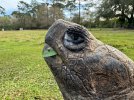I agree with your head description. I don't much care for the pointy noses, but I love the blocky square heads of the Galapagos. For the same reason I prefer the look of the Eastern hermanni instead of the greeks.I have only been around one Galapagos, squarer flat head and blunt square nose is what I would describe them having and always the goopy eyes, even most pictures they have it. The Aldabra has the pointier nose in my opinion rounder head and I have never seen goopy eyes.
One day I will have to visit the Galapagos at our Brookfield Zoo. Just to see how they behave. Probably no where near the same as one private owned I'm sure.
Seeing either of them in a zoo isn't going to give you much insight. You'll just get a snapshot of whatever they are doing for those few minutes you are standing there. Come to CA. I'll take you to places where you can put hands on them and sit for hours with an iced tea or a fruity drink of your choice. I'll text you some pics tomorrow.


